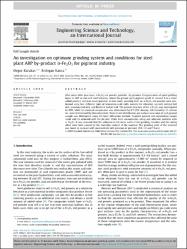| dc.contributor.author | Karakaş, Özgür | |
| dc.contributor.author | Kanca, Erdoğan | |
| dc.date.accessioned | 2020-05-24T14:24:15Z | |
| dc.date.available | 2020-05-24T14:24:15Z | |
| dc.date.issued | 2020 | |
| dc.identifier.citation | Karakas, O., Kanca, E. (2020) . An investigation on optimum grinding system and conditions for steel plant ARP by-product α-Fe2O3 for pigment industry. Engineering Science and Technology, an International Journal.
https://doi.org/10.1016/j.jestch.2020.03.005 | en_US |
| dc.identifier.issn | 2215-0986 | |
| dc.identifier.uri | https://doi.org/10.1016/j.jestch.2020.03.005 | |
| dc.identifier.uri | https://hdl.handle.net/20.500.12508/1046 | |
| dc.description.abstract | After some other processes, ?-Fe2O3 red powder particles -by-product of regeneration of spent pickling liquor in ARP in iron and steel industry- should be ground up to pigment grade to convert it to a value added product, red iron oxide pigment. In this study, grinding tests on ?-Fe2O3 red powder were performed using four different types of laboratory-scale mills, namely the vibrating cup mill, vertical ball mill, planetary ball mill, and fluidized bed jet mill. The particle structure of the ?-Fe2O3 was investigated by SEM, while its chemical composition was determined by ICP-OES, density, LOI, humidity, Cl content etc. were determined by laboratory tests. Particle size distribution and surface area value of each ground sample was determined using the laser diffraction method. Targeted particle size distribution ranges could only be achieved with the jet mill. Other mills encountered caking and adhesion problem with ?- Fe2O3. It was assessed that the adhesion to the inner walls of the grinding chamber and the caking effect were both caused by the humidity content of the material. The grinding yield of the material was found to increase with increased jet mill grinding air pressure (0.8, 3.2 and 7 bars). © 2020 Karabuk University | en_US |
| dc.description.sponsorship | 3170019 Türkiye Bilimsel ve Teknolojik Araştırma Kurumu | en_US |
| dc.description.sponsorship | This study is supported by the Scientific and Technological Research Council of Turkey (TÜBİTAK, Project No. 3170019). We would like to express our thanks to MMK Metalurji CEO Mr. Denis Kvasov, who showed close interest in the project and allowed us to work on the pickling and acid regeneration lines and make use of the laboratory infrastructure of MMK Metalurji. | en_US |
| dc.language.iso | eng | en_US |
| dc.publisher | Elsevier B.V. | en_US |
| dc.relation.isversionof | 10.1016/j.jestch.2020.03.005 | en_US |
| dc.rights | info:eu-repo/semantics/openAccess | en_US |
| dc.subject | Dry grinding | en_US |
| dc.subject | Iron and steel | en_US |
| dc.subject | Jet mill | en_US |
| dc.subject | Red iron oxide pigment | en_US |
| dc.subject | α-Fe2O3 | en_US |
| dc.subject.classification | Pickling | Descaling | Hydrochloric acid | en_US |
| dc.title | An investigation on optimum grinding system and conditions for steel plant ARP by-product α-Fe2O3 for pigment industry | en_US |
| dc.type | article | en_US |
| dc.relation.journal | Engineering Science and Technology, an International Journal | en_US |
| dc.contributor.department | Mühendislik ve Doğa Bilimleri Fakültesi -- Makina Mühendisliği Bölümü | en_US |
| dc.relation.publicationcategory | Makale - Uluslararası Hakemli Dergi - Kurum Öğretim Elemanı | en_US |
| dc.contributor.isteauthor | Kanca, Erdoğan | en_US |
| dc.relation.index | Scopus | en_US |
















